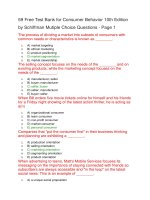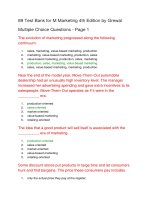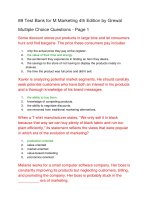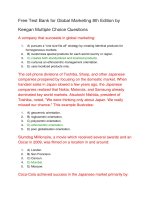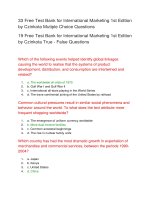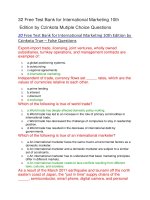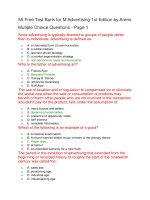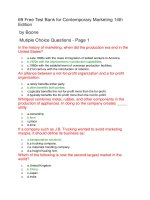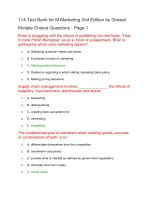Free test bank for strategic marketing 10th edition by
Bạn đang xem bản rút gọn của tài liệu. Xem và tải ngay bản đầy đủ của tài liệu tại đây (55.51 KB, 17 trang )
Free Test Bank for Strategic Marketing 10th Edition by
Cravens Multiple Choice Questions
_____ is a business perspective that makes the customer the focal
point of a company’s total operations.
1.
2.
3.
4.
A. Market orientation
B. Competitive parity
C. Value chain integration
D. Business scaffolding
Which of the following stages of marketing strategy process
considers organizational design and marketing strategy
implementation and control?
1.
2.
3.
4.
A. Implementing and managing market-driven strategy
B. Designing market-driven strategy
C. Identifying and evaluating markets, segments, and customer value
D. Market-driven program development
_____ are described by different characteristics of customers, the
reasons that they buy or use certain products, and their preferences
for certain brands of products.
1.
2.
3.
4.
A. Market shares
B. Strategic marketing objectives
C. Market segments
D. Corporate capabilities
Which of the following activities is an example of promotion
strategy?
1.
2.
3.
4.
A. Distinctive capabilities
B. Benchmarking
C. Public relations
D. Product positioning
_____ examines customer targeting and positioning strategies,
marketing relationship strategies, and innovation and new product
strategy.
1.
2.
3.
4.
A. Identifying markets, segments, and customer value
B. Implementing and managing market-driven strategy
C. Designing market-driven strategy
D. Market-driven program development
_____ consist(s) of deciding the scope and purpose of the
business, the objectives, and the resources necessary to achieve
the objectives.
1.
2.
3.
4.
A. Marketing strategy
B. Corporate strategy
C. Market sensing
D. Channel bonding
_____ is the combination of the product, value chain, price, and
promotion strategies a firm uses to place itself against its key
competitors in meeting the needs and wants of the buyers in the
market target.
1.
2.
3.
4.
A. Positioning strategy
B. Customer relationship management
C. Customer linking
D. Market targeting strategy
Getting all business functions working together to provide superior
customer value is referred to as _____.
1.
2.
3.
4.
A. customer relationship management
B. competitor intelligence
C. cross-functional coordination
D. centralization
In a corporate strategy, _____ indicate(s) the dimensions of
performance upon which to focus and the levels of achievement
required.
1.
2.
3.
4.
A. corporate objectives
B. synergies
C. vision
D. scope
_____ are complex bundles of skills and accumulated knowledge,
excised through organizational processes, that enables firms to
coordinate activities and make use of their assets.
1.
2.
3.
4.
A. Business clusters
B. Competitor faculties
C. Cross functions
D. Distinctive capabilities
With regard to a corporate strategy framework, _____ define(s)
what the corporation is and what it does and provides important
guidelines for managing and improving the corporation.
1.
2.
3.
4.
A. resource allocation
B. synergies
C. objectives
D. management’s vision
Which of the following stages of marketing strategy process
consists of brand, value-chain, pricing, and promotion and selling
strategies designed and implemented to meet the value
requirements of targeted buyers?
1.
2.
3.
4.
A. Implementing and managing market-driven strategy
B. Designing market-driven strategy
C. Identifying and evaluating markets, segments, and customer value
D. Market-driven program development
Which of the following is the final component of the corporate
strategy?
1.
2.
3.
4.
A. Scope
B. Synergy
C. Corporate objective
D. benchmarking
The purpose of _____ is to select the people (or organizations) that
management wishes to serve in the product-market.
1.
2.
3.
4.
A. strategic positioning
B. benchmarking
C. customer linking
D. market targeting strategy
_____ seeks to place the brand in the eyes and mind of the buyer
and distinguish the product from those in competition.
1.
2.
3.
4.
A. Customer relationship strategy
B. Positioning strategy
C. Benchmarking
D. Value-chain strategy
With regard to corporate strategy, _____ is/are concerned with
resolving questions about the business the firm should be in, where
it should focus, and its enduring strategic purpose.
1.
2.
3.
4.
A. corporate objectives
B. synergies
C. scope
D. resource allocation
Which of the following is the first step in a marketing strategy
process?
1.
2.
3.
4.
A. Market-driven program development
B. Designing market-driven strategy
C. Identifying and evaluating markets, segments, and customer value
D. Implementing and managing market-driven strategy
_____ consist(s) of the benefits and costs resulting from the
purchase and use of products as perceived by the buyer.
1.
2.
3.
4.
A. Customer value
B. Distinctive capabilities
C. Spanning process
D. Market sensing
_____ offer(s) a company the opportunity to focus its business on
the requirements of one or more groups of buyers.
1.
2.
3.
4.
A. Corporate resources
B. Market segmentation
C. Business composition
D. Distinctive capabilities
A _____ is a single product or brand, a line of products, or a mix of
related products that meets a common or a group of related market
needs, and its management is responsible for the basic unctions.
1.
2.
3.
4.
A. market section
B. strategic business unit
C. business segment
D. marginal piece
20 Free Test Bank for Internet Marketing 3rd Edition by
Roberts Multiple Choice Questions
The Internet experienced slow but steady growth until ________
allowed users to move around in easy graphical fashion.
1.
2.
3.
a. Yahoo!
b. Mosaic
c. Netscape
Which of the following is not a strategic driver of the Internet
economy?
1.
2.
3.
a. Speed is essential to successful Internet operations.
b. Employees can easily be substituted for one another.
c. Making it possible to deal with customers on a 1-to-1 basis.
________ is the communications protocol that provides the
common “language” of Internet computing.
1.
2.
3.
a. TCP/IP
b. HTML
c. The graphic browser
Which is not among the four distinct generic goals of Internet
marketing?
1.
2.
3.
a. Acquisition
b. Conversion
c. Mobile access
The most common way consumers discover new online products is
through:
1.
2.
3.
a. search.
b. merchant emails.
c. social networking sites.
Objectives that can be appropriate for Internet marketing include:
1.
2.
3.
a. building loyal customer relationships.
b. doubling the customer base.
c. decreasing the need for customer service.
Which of the following is a true statement about the origins of the
Internet?
1.
a. The Internet was initially conceptualized in a term paper by a computer
science student at Stanford.
2. b. The Internet was initially developed by a number of technology companies
that wanted to expand the market for their products.
3. c. The Internet was initially developed by DARPA to fund research in
communications technology for defense purposes.
The basic business models used on the Internet include:
1.
2.
3.
a. multi-channel marketing.
b. target return on investment.
c. disintermediation.
Businesses have enthusiastically adopted the internet for marketing
for the following:
1.
2.
3.
a. attract new customers.
b. customer retention.
c. both of the above.
The phenomenon we call "the Internet bubble" was characterized
by:
1.
2.
a. many Internet businesses that had not attained profitability.
b. venture capital available to even questionable business models.
3.
c. both of the above.
The Sabre System is an example of:
1.
2.
3.
a. a new service made possible by the Internet.
b. an information product.
c. a product targeted solely at the consumer market.
A website must be hosted on a ________.
1.
2.
3.
a. browser
b. interactive device
c. server
Term often used when software is made available on a fee for
usage basis:
1.
2.
3.
a. Applications Software Providers.
b. Proprietary Software.
c. Software as a Service.
Which of the following is not an element of the Internet
infrastructure stack?
1.
2.
3.
a. Website content
b. Operations like load balancing and security
c. Connections to the telecommunications backbone of the Internet
________ is the feature of the Internet that allows users to move
easily from one document to another.
1.
2.
3.
a. Telecommunications
b. Common platform
c. Hypertext
Sales force.com exemplifies:
1.
a. a “cloud computing” product that shows the power of connectivity in a
network.
2. b. a proprietary product used by a single user.
3. c. technology that is used primarily to develop proprietary software.
Web 2.0 is characterized by:
1.
2.
3.
a. services and co-creation.
b. economic and technical evolution.
c. a "dot com" business enterprise.
Technology that can integrate location into marketing applications is
called:
1.
2.
a. apps.
b. Web 3.0.
3.
c. GPS.
The Sabre System is an example of:
1.
2.
3.
a. an information product that existed prior to the Internet.
b. the evolution of an internal system into a commercial product.
c. both of the above.
Which of the following is a true statement about the Internet
infrastructure stack?
1.
a. It describes activities that can be performed inside the business or
outsourced to independent suppliers.
2. b. It describes the manner in which different elements come together to create
the Internet environment.
3. c. Both of the above.
48 Free Test Bank for Global Marketing 8th Edition by
Keegan Multiple Choice Questions
Based on the size of the market in U.S. dollars, the leading
consumer products are:
1.
2.
3.
4.
5.
A) cell phones.
B) bottled water.
C) cigarettes.
D) video games.
E) recorded music.
In the United States, some people believe that globalization has
depressed the wages of American workers and resulted in the loss
of both blue-collar and white-collar jobs. This is an example of:
1.
2.
3.
4.
5.
A) discrimination.
B) domination.
C) globaphobia.
D) management myopia.
E) economic crisis.
Uniqlo, a division of Japan's Fast Retail, operates about 850 stores
in Japan and currently has six stores in the United States. Their
plans call for a total of 200 U.S. stores by 2020. The fulfillment of
their plan will depend on:
1.
2.
3.
4.
5.
A) industry conditions.
B) sources of competitive advantage.
C) the condition of the apparel market worldwide.
D) the demand in Japan for U.S. style garments.
E) all of the above
When you call United Airlines for a reservation on a toll-free number
and get a response from an operator in Mumbai, this is an example
of:
1.
2.
3.
4.
5.
A) anti-globalization.
B) global marketplace.
C) multilingual expression.
D) discrimination.
E) E-ticketing.
Walmart's exit from the German market was due, in part, to the fact
that German shoppers could find lower prices at stores known as:
1.
2.
3.
4.
5.
A) All-in-one stores.
B) Dollar stores.
C) Discount sores.
D) Hard discounters.
E) Fresh & Easy stores.
Nissan's earlier vehicles were difficult to start in many parts of the
United States during the cold winter months. In northern Japan, it
was customary for many car owners to put blankets over the hoods
of their cars during winter months. Nissan's assumption was that
Americans would do the same thing. This is an example of:
1.
2.
3.
4.
5.
A) ethnocentric orientation.
B) polycentric orientation.
C) regiocentric orientation.
D) geocentric orientation.
E) geopolitic orientation.
Starbucks is building on its loyalty card and rewards program in the
United States with a smartphone app that enables customers to pay
for purchases electronically. The app displays a bar code that the
barista can scan. This is an example of:
1.
2.
3.
4.
5.
A) Market Penetration.
B) Market Development.
C) Market Diversification.
D) Product Development.
E) Global Marketing.
When a country like China is experiencing rapid economic growth,
policymakers are likely to:
1.
2.
3.
A) look more favorably on outsiders.
B) look less favorably on outsiders.
C) experience more resistance toward outsiders.
4.
5.
D) feel threatened by outsiders.
E) None of the above
From the global marketing perspective, the customization of the
Beatles' records is a good example of:
1.
2.
3.
4.
5.
A) product adaptation.
B) market penetration.
C) diversification.
D) product development.
E) marketing mix.
Starbucks is entering India via an alliance with the Tata Group.
Phase 1 calls for sourcing coffee beans in India and marketing them
at Starbucks stores throughout the world. This is an example of:
1.
2.
3.
4.
5.
A) Market Penetration.
B) Market Development.
C) Market Diversification.
D) Product Development.
E) Regular Marketing.
The cell phone divisions of Toshiba, Sharp, and other Japanese
companies prospered by focusing on the domestic market. When
handset sales in Japan slowed a few years ago, the Japanese
companies realized that Nokia, Motorola, and Samsung already
dominated key world markets. Atsutoshi Nishida, president of
Toshiba, noted, "We were thinking only about Japan. We really
missed our chance." This example illustrates:
1.
2.
3.
4.
5.
A) geocentric orientation.
B) regiocentric orientation.
C) polycentric orientation.
D) ethnocentric orientation.
E) poor globalization orientation.
Pfizer, Merck, Novartis, and other pharmaceutical companies have
little choice but to engage in global marketing since:
1.
2.
3.
4.
5.
A) there is little demand for their products in home countries.
B) their research centers are located overseas.
C) no single market is large enough to recover costs incurred in research.
D) there is more demand overseas for their products.
E) technology is not available in home countries.
Examples of effective global marketing by McDonald's include both
standardized and localized marketing mix elements. Which of the
following does not represent a localized element?
1.
2.
3.
4.
5.
A) It serves McAloo tikki potato burger in India.
B) It uses the advertising slogan "I'm lovin' it."
C) It operates themed dining cars on the Swiss national rail system.
D) It has home delivery service in India.
E) It has slang nicknames such as MakDo in Philippines and McDo in France.
Statements that illustrate the success of global marketing include all
of the following except:
1.
2.
3.
4.
5.
A) the Coca-Cola Company supports its Coke brand by utilizing global and
local marketing mix.
B) Apple is synonymous with cutting-edge innovation and high-tech design.
C) Italy's Benetton utilizes marketing as a knee-jerk reaction to world
marketing needs.
D) the backbone of Caterpillar's global success is its network of dealers.
E) Germany's reputation for engineering and manufacturing provides a
competitive advantage.
Two decades ago, professor Ted Levitt wrote a classic Harvard
Business Review article titled "The Globalization of Markets." Which
of the following statements about the author and the article is
accurate?
1.
2.
A) Levitt urged companies to adopt products on a country-by-country basis.
B) There was universal agreement about his thesis that the world is becoming
homogeneous.
3. C) Levitt urged companies to develop standardized products that could be
marketed worldwide with little adaptation.
4. D) Levitt warned of the coming backlash against globalization.
5. E) Levitt did not recommend developing standardized products.
Measured by national income, the United States represents the
world's largest single market for goods and services. Roughly what
percentage of world income is found outside the United States?
1.
2.
3.
4.
5.
A) 25%
B) 50%
C) 75%
D) 95%
E) 35%
According to the Fortune global 500 companies for 2012, the
largest corporation based on revenue is:
1.
2.
3.
4.
5.
A) Exxon Corporation.
B) Toyota Motors.
C) Royal Dutch Shell.
D) General Electric.
E) Walmart stores.
In an effort to "Americanize" the sound of the Beatles' recordings, a
studio effect known as reverb was added to some tracks. This is an
example of:
1.
2.
3.
4.
5.
A) product adaptation.
B) market penetration.
C) diversification.
D) product development.
E) marketing mix.
In global markets, Starbucks is a good example of simultaneously
executing all of the growth strategies except:
1.
2.
3.
4.
5.
A) Market penetration.
B) Market development.
C) Product development.
D) Market orientation.
E) Diversification.
Starbucks has launched several new ventures in global markets,
including music CDs and movie production. This is an example of:
1.
2.
3.
4.
5.
A) Market Penetration.
B) Market Development.
C) Market Diversification.
D) Product Development.
E) Global Marketing.
An important managerial task in global marketing is learning to
recognize the extent to which it is possible to extend marketing
plans as well as the extent to which adaptation is desired. The way
a company addresses this task is a reflection of the company's:
1.
2.
3.
4.
5.
A) market penetration.
B) market diversification.
C) global marketing strategy.
D) product development.
E) product standardization.
A number of multilateral trade agreements have accelerated the
pace of global integration which include:
1.
2.
3.
4.
5.
A) NAFTA.
B) GATT.
C) WTO.
D) EU.
E) all of the above
Coca-Cola achieved success in the Japanese market primarily by:
1.
2.
3.
4.
5.
A) standardization of marketing mix elements.
B) global localization.
C) vending machine operations.
D) selecting market mix options.
E) homogenization.
Based on the size of the market in U.S. dollars, the second highest
consumer products are:
1.
2.
3.
4.
5.
A) luxury goods.
B) cell phones.
C) cigarettes.
D) bottled water.
E) recorded music.
One of the dimensions of global marketing strategy which pertains
to marketing management is:
1.
2.
3.
4.
5.
A) concentration of market penetration.
B) coordination of market diversification.
C) integration of competitive moves.
D) coordination of product development.
E) product standardization.
The marketing mix is integral to the value equation which is
represented by:
1.
2.
3.
4.
5.
A) Value = Price/Benefits.
B) Value = Benefits/Price.
C) Value = Benefits × Price.
D) Value = Benefits - Price.
E) Value = Benefits + Price.
Anheuser-Busch, the brewer of Budweiser beer, lost its
independence after years of focusing primarily on the domestic U.S.
market. This is most likely a result of:
1.
2.
3.
4.
5.
A) management myopia.
B) national controls.
C) opposition to globalization.
D) newcomers from emerging markets.
E) organizational culture.
A company that succeeds in global marketing:
1.
A) pursues a "one size fits all" strategy by creating identical products for
homogeneous markets.
2. B) customizes special products for each world country or region.
3. C) creates both standardized and localized products.
4. D) nurtures an ethnocentric management orientation.
5.
E) uses localized products only.
Japan's giant Matsushita Electric Company achieved scale
economies by exporting VCRs, televisions, and other consumer
electronics products throughout the world from world-scale factories
in Japan. This is an example of the fact that:
1.
2.
3.
4.
5.
A) scale economies were a cornerstone of Japanese success in the 1970s
and 1980s.
B) leverage from scale economies is not limited to manufacturing.
C) a global company can achieve the same economies on a global scale.
D) the larger scale of the global company also creates opportunities to
improve corporate staff competence and quality.
E) all of the above
According to Michael Porter, a global industry is one in which
________ can be achieved by integrating and leveraging operations
on a worldwide scale.
1.
2.
3.
4.
5.
A) marketing mix
B) competitive advantage
C) cross border infiltration
D) ration analysis
E) production capability
The essence of marketing worldwide is to surpass the competition
in creating perceived value, which can be represented as:
1.
2.
3.
4.
5.
A) Value = Price/Benefits.
B) Value = Benefits/Price.
C) Value = Benefits × Price.
D) Value = Benefits - Price.
E) Value = Benefits + Price.
Based on the total annual units sold in the worldwide market, the
leading product category is:
1.
2.
3.
4.
5.
A) flat-panel TV sets.
B) cigarettes.
C) cell phone handsets.
D) cars and light trucks.
E) HDTV sets.
Even though Germany is the largest single-country market in
Europe, what percent of the world market potential for German
companies is outside Germany?
1.
2.
A) 40%
B) 55%
3.
4.
5.
C) 74%
D) 94%
E) 85%
Slumdog Millionaire, a movie which received several awards and an
Oscar in 2009, was filmed on a location in and around:
1.
2.
3.
4.
5.
A) London.
B) San Francisco.
C) Cancun.
D) Mumbai.
E) Moscow.
Nike recently adopted the slogan "Here I am" for its pan-European
clothing advertising targeting women. The decision to drop the
famous "Just do it" tag line was based on the research indicating
that:
1.
2.
3.
4.
5.
A) the famous slogan did not have accurate translation in European
languages.
B) Europeans do not like tag lines that portray American thinking.
C) college-age women in Europe are not as competitive about sports as men
are.
D) the old slogan conveys superiority of men over women.
E) European women want to differentiate themselves from men.
Unilever, the Anglo-Dutch consumer products company, at one time
had 30 different package designs and 48 different formulations for
its Rexona deodorant brand. This is an example of:
1.
2.
3.
4.
5.
A) ethnocentric orientation.
B) polycentric orientation.
C) regiocentric orientation.
D) geocentric orientation.
E) transnational orientation.
Nestlé, Unilever, GlaxoSmithKline, and Royal Philips Electronics
can be considered transnational companies on the basis of:
1.
2.
3.
4.
5.
A) sales outside the home country to total sales.
B) assets outside the home country to total assets.
C) employees outside the home country to total employees.
D) headquartered in a relatively small home-country market.
E) all of the above
A type of advantage that a global company possesses by virtue of
the fact that it has experience in more than one country is referred
to as:
1.
2.
3.
4.
5.
A) Leverage.
B) Transferability.
C) Flexibility.
D) Capability.
E) Enability.
In their book, Daniel Yergin and Joseph Stanislaw wrote "It is the
greatest sale in the history of the world. Governments are getting
out of businesses by disposing of what amounts to trillions of dollars
of assets. Everything is going—from steel plants and phone
companies . . . to hotels, restaurants, and nightclubs." This is an
indication of:
1.
2.
3.
4.
5.
A) the fact that governments can make more money by selling assets.
B) privatization is becoming a driving force for global marketing.
C) these businesses are considered as closed markets.
D) foreign companies are competing with governments.
E) there is less demand for these type of companies.
Based on 2012 rankings of Fortune Global 500 companies, the
world's most valuable car company is:
1.
2.
3.
4.
5.
A) GM.
B) Daimler AG.
C) Toyota.
D) Ford.
E) Chrysler.
All of the following correctly states McDonald's approach to
standardization and adaptation of the marketing mix except:
1.
2.
3.
4.
5.
A) McDonald's standardizes some product elements and adapts others.
B) McDonald's standardizes some place elements and adapts others.
C) McDonald's standardizes some promotion elements and adapts others.
D) McDonald's standardizes some price elements and adapts others.
E) McDonald's standardizes all product elements.
A person who assumes that his or her home country is superior to
the rest of the world is said to have:
1.
2.
3.
4.
5.
A) ethnocentric orientation.
B) polycentric orientation.
C) regiocentric orientation.
D) geocentric orientation.
E) None of the above
A fundamental difference between regular marketing and global
marketing is:
1.
2.
3.
4.
5.
A) the lack of marketing mix.
B) the scope of activities.
C) the lack of strategic planning.
D) the focus on resources.
E) the lack of communication.
The decision to enter one or more particular markets outside the
home country depends on all of the mentioned factors except:
1.
2.
3.
4.
5.
A) company's resources.
B) company's age.
C) company's managerial mind-set.
D) nature of opportunities.
E) threats.
The former chairman of Nestlé recently told an interviewer: "We are
food and beverages. We are not running bicycle shops. Even in
food we are not in all fields. There are certain areas we do not
touch. Also, we have no soft drinks because I have said we either
buy Coca-Cola or we leave it alone." What strategic marketing
principle does the chairman's comment emphasize most
specifically?
1.
2.
3.
4.
5.
A) customer value
B) competitive advantage
C) focus
D) myopia
E) policy of dealing only with Swiss businesses
McDonald's serves McAloo Tikki Burger in India, McRice Burger in
Malaysia, McOZ Burger in Australia, Kiwi Burger in New Zealand,
and McHuevo Burger in Uruguay and McSamurai Burger in
Thailand. These menu variations are examples of:
1.
2.
3.
4.
5.
A) a combination of global and local marketing mix elements.
B) a reflection of failure of U.S. menu items in those countries.
C) a deviation from successful marketing practices.
D) a replacement of standard menu names with fancy names.
E) a selection of menu items that can be sold eventually in U.S. markets.
Renault and its rivals are racing to offer middle-class consumers a
new value proposition by selling cars for the equivalent of $10,000
or less. On the heels of Renault's success with Dacia Logan came
the $2,500 Nano from India's Tata Motors. This illustrates that:
1.
2.
A) consumers are looking for low price irrespective of quality.
B) Renault is overcharging for their cars compared to their competitors.
3.
4.
C) higher product development costs are a driving force behind globalization.
D) market success depends on reaching a threshold of acceptable quality for
consumers.
5. E) cars are not very popular in emerging markets like India.
Transnational companies, such as Toyota and Honda, have
characteristic features that include:
1.
2.
3.
4.
5.
A) being in both global markets and utilizing global supply chains.
B) characterized by a mind-set of being "stateless."
C) using both localized and standardized elements in marketing programs.
D) decisions made on the basis of ongoing research.
E) all of the above
Total Points: 0 correct out of 48
